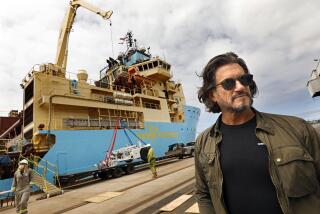Editorial: That Antarctic ozone hole the world thought it was fixing? There may be a glitch
This is a problem the world thought it had fixed.
Scientists discovered in the 1980s that chlorofluorocarbons — used for refrigeration and in aerosol sprays — were creating a hole in the stratospheric ozone layer far above Antarctica, which could have devastating consequences for life on Earth. (Ozone absorbs much of the sun’s cancer-causing and DNA-altering ultraviolet rays, keeping them from reaching the planet’s surface.) So the world’s nations came together in Montreal and agreed in 1987 to ban specific chemicals that damage atmospheric ozone. In the years since, the ozone hole has been slowly healing.
A team of scientists says it has discovered that ozone levels at lower altitudes have decreased.
But now a team of scientists says it has discovered that ozone levels at lower altitudes have decreased — and not over Antarctica, but between the 60-degree latitudes, where the vast majority of the world’s population lives. It is only one study, and it’s not definitive, but independent climate scientists say the findings are troubling, the potential consequences are dire and more study and analysis are necessary to understand what is happening and how to address it.
They’re right. The study, published in the Europe-based Atmospheric Chemistry and Physics journal, raises more questions than it answers, but it reveals a potentially significant and unanticipated environmental problem. The causes are murky. It could be that global warming is shifting weather patterns that, in turn, are moving ozone out of the region. Or it’s possible that increasing emissions of unidentified chemicals could be to blame. To be sure, further study could also find that what these scientists discovered has a benign explanation, or prove their observations to be more of a blip than a trend.
But that’s why we have science — to find such answers. The global environment is incredibly complex, and we still don’t fully understand how human activity — from the cars we drive to the homes we heat to the plants we cultivate — affects it. It’s worth noting that the Antarctic ozone hole has been shrinking because the global community recognized the problem, came together in an international effort to understand it and took concrete steps to resolve it.
In an article on the new ozone study, Scientific American makes a point that bears emphasizing: Crafting an environmental policy to address a specific problem is just the early stage of the process. It must be followed by testing, monitoring, and reassessments of how the policy works, whether the result is what was intended and whether the problem is being resolved or just mitigated. Continued focus and follow-up could well lead to the realization that the ozone in the atmosphere is at risk in varying places and from varying factors. Knowledge, as they say, is power — but it’s limited by the political will to act on that knowledge.
There’s a lesson in that for our approach to combating global warming. Despite the deniers in the Trump administration, climate change is occurring, and it is due in large part to a couple of centuries of humans burning fossil fuels for energy — from coal to oil to natural gas. Climate scientists are trying to better understand the vagaries of those effects, which may be driving unusual winter cold snaps in the northern U.S., Europe and Siberia even as the Arctic itself is warmer than it should be. Some scientists suspect that warming air and seas are affecting jet streams and ocean currents, which shift weather patterns.
We need to know more, and that requires concentrated, multinational efforts to study and understand what’s happening. As with the effort to address ozone depletion, the world’s nations — led at the time by the U.S. — came together in Paris in 2015 and agreed to reduce greenhouse gas emissions to try to keep the rise in global temperatures to no more than 2 degrees Celsius over pre-industrial age levels. That’s the agreement that President Trump has vowed to quit, which would make the U.S. the only nation in the world not part of the pact.
International science-based cooperation has helped the world grapple with human-caused ozone depletion, even if we’re still sorting out the full scope of the problem and the impacts of the solutions to date. We need to pursue the same strategy to combat global warming. There are answers, and solutions, to be found. Let’s find them.
Follow the Opinion section on Twitter @latimesopinion or Facebook
More to Read
A cure for the common opinion
Get thought-provoking perspectives with our weekly newsletter.
You may occasionally receive promotional content from the Los Angeles Times.










